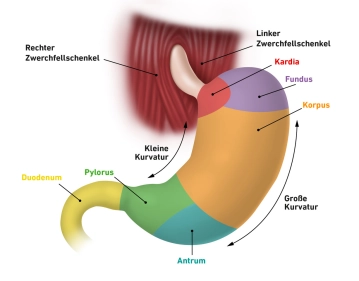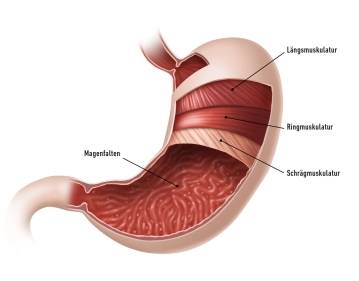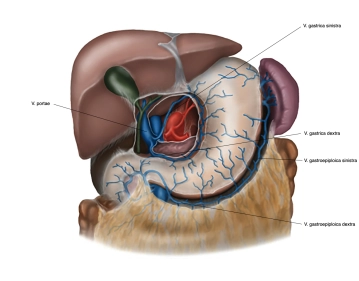- The stomach is a muscular hollow organ between the esophagus and duodenum. It is located in the left and middle upper abdomen directly below the diaphragm. The stomach is on average 25 to 30 cm long when moderately filled and has a capacity of 1.5 liters, in extreme cases up to 2.5 liters. The position, size, and shape of the stomach vary greatly depending on age, filling state, and body position. There are large interindividual differences.
- The stomach is divided into different sections:
- Cardia (stomach entrance, upper stomach mouth, Ostium cardiacum):
The cardia is a 1-2 cm long area where the esophagus opens into the stomach. Here is the sharp transition from the esophageal mucosa to the gastric mucosa, which is usually well recognizable with the endoscope. - Fundus gastricus: Above the stomach entrance, the fundus arches upwards, also called the stomach dome or fornix gastricus. The fundus is usually filled with air that is involuntarily swallowed while eating. In a standing person, the fundus forms the highest point of the stomach, so that in an X-ray image the accumulated air is visible as a "stomach bubble." Opposite the stomach entrance, the fundus is demarcated by a sharp fold (Incisura cardialis).
- Corpus gastricum (stomach body): The stomach body forms the main part of the stomach. Here are deep longitudinal folds of the mucosa (Plicae gastricae), which extend from the stomach entrance to the pylorus and are also referred to as the "gastric canal."
- Pylorus (Pars pylorica, stomach gatekeeper):
This section begins with the expanded antrum pyloricum, followed by the gatekeeper canal (Canalis pyloricus) and ends with the actual stomach gatekeeper (Pylorus). Here is the stomach sphincter muscle (M. sphincter pylori), which consists of a strong circular muscle layer and closes the lower stomach mouth (Ostium pyloricum). The pylorus regulates the stomach exit and periodically allows small amounts of food pulp (chyme) to pass into the subsequent duodenum.
- Cardia (stomach entrance, upper stomach mouth, Ostium cardiacum):
The stomach is located intraperitoneally and is thus covered with a serosa layer; only the dorsal cardia is free of serosa. Due to the embryonic stomach rotation, the original mesogastria move from their sagittal position to a frontal orientation: The lesser omentum runs from the lesser curvature to the liver portal, while the greater omentum spreads from the greater curvature to the transverse colon, spleen, and diaphragm.
The stomach is anchored and stabilized in the abdominal cavity by ligaments that extend to the liver and spleen, among others. With its convex side, it forms the greater curvature (Curvatura major) and with its concave side the lesser curvature (Curvatura minor). The front wall is referred to as Paries anterior and the back wall as Paries posterior. The greater omentum originates from the area of the greater curvature, while the lesser omentum spans between the left liver lobe and the lesser curvature.
Topographical Anatomy of the Stomach
Ventral (front):
- The front wall of the stomach lies mostly directly against the abdominal wall.
- In the upper area, it borders on the left liver lobe (Lobus sinister hepatis).
Dorsal (back):
- Behind the stomach lies the omental bursa (lesser sac).
- Important neighboring structures are the pancreas (Pankreas), the spleen (Splen), the left kidney, and the adrenal gland.
Cranial (above):
- The stomach entrance (Cardia) is in direct proximity to the esophagus (Ösophagus) and the diaphragm.
- The fundus is located below the left diaphragm area and borders on the spleen.
Caudal (below):
- The stomach transitions through the pylorus into the duodenum, which is already located in the right upper abdomen.
Lateral (sideways):
- On the left side, the stomach is bordered by the spleen, which is connected to it via the Lig. gastrosplenicum.
- On the right side, the lesser curvature is in contact with the liver portal (Porta hepatis).





